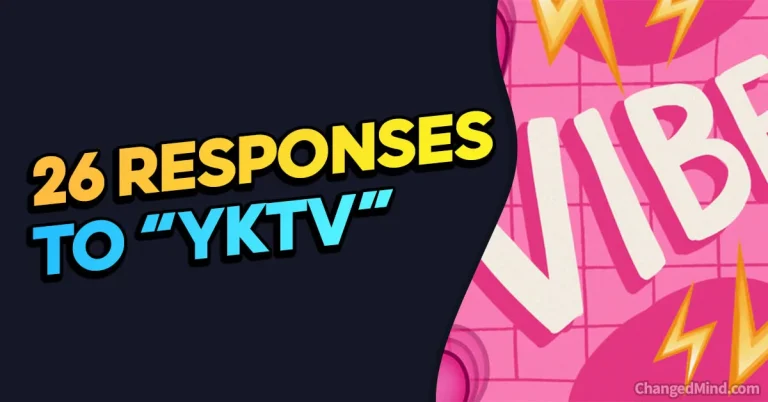Feeling like a broken record with your endless “No Worries”? Well, it’s time to jazz up your response repertoire! In this article, we’re diving headfirst into the delightful world of alternative phrases.
Yes, you guessed it, we’ve got “26 Other Ways to Say ‘No Worries'” lined up just for you!
From the lighthearted to the suave, we’ve got every scenario covered. Whether you want to add a dash of humor, sprinkle some sophistication, or simply break the monotony, we’ve got your back.
So, why stick to the ordinary when you can spice up your responses
Buckle up, because we’re about to make your conversations a whole lot more exciting. In this article, we’ll cover:
- Creative alternatives for casual reassurance.
- Expressions to match your mood and style.
- Cultural variations and global perspectives.
- Why diversifying your responses matters.
Ready to transform your “No Worries” game? Let’s dive in!
The phrase “No Worries” has become a common and casual way to express reassurance and let someone know that there is no cause for concern.
It is often used to show understanding, acceptance, or to alleviate any anxieties in a situation.
But what are some other ways to convey the same sentiment? Understanding alternative phrases or expressions can provide us with a wider range of options for communication.
Here are ten alternative ways to say “No Worries”:
- No Problem
- Not at All
- It’s Fine
- Don’t Mention It
- No Trouble
- It’s Alright
- No Hassle
- No Need to Worry
- It’s OK
- No Big Deal
These alternative phrases offer similar meanings and can be used interchangeably depending on the context and personal preference. By exploring these variations of expressing reassurance, we can enhance our communication skills and diversify our language usage.
Key takeaway:
- There are several alternative phrases to express “No Worries” in English.
- Examples of other ways to say “No Worries” include “No Problem,” “Not at All,” “It’s Fine,” “Don’t Mention It,” and “No Trouble.”
- Other possible phrases include “It’s Alright,” “No Hassle,” “No Need to Worry,” “It’s OK,” and “No Big Deal.”

26 Other Ways to Say “No Worries”
Here are 26 other ways to say “No Worries”:
- No problem.
- It’s all good.
- Don’t mention it.
- It’s fine.
- No sweat.
- You’re welcome.
- Not an issue.
- No big deal.
- That’s okay.
- It’s cool.
- Forget about it.
- All is well.
- No need to fret.
- No need to apologize.
- It’s a breeze.
- It’s under control.
- No concerns.
- It’s handled.
- Everything’s fine.
- It’s sorted.
- No trouble at all.
- No need to stress.
- It’s in hand.
- No need for thanks.
- It’s taken care of.
- Consider it done.
These phrases can be used to convey reassurance, acceptance, and a lack of concern in various casual and polite contexts.
26 Polite Ways to Say “No Worries”
Here are 26 polite ways to say “No Worries”:
- Not a problem.
- No trouble at all.
- It’s quite alright.
- There’s no inconvenience.
- It’s my pleasure.
- You needn’t worry.
- No need for concern.
- It’s perfectly fine.
- Don’t give it a second thought.
- It’s of no consequence.
- It’s no imposition.
- You’re absolutely welcome.
- It’s all within expectations.
- No need to be troubled.
- Please, no need to fret.
- It’s all part of the service.
- You have nothing to apologize for.
- You’re in the clear.
- It’s all in good order.
- It’s simply routine.
- No need to feel uneasy.
- You’re not causing any bother.
- There’s no disruption.
- You’re not imposing at all.
- No need to be concerned.
- It’s just fine with me.
These phrases maintain a polite and courteous tone, perfect for expressing reassurance and gratitude while minimizing any perceived inconvenience or worry.
Why Do We Say “No Worries”?
When it comes to language, expressions often have interesting origins. “No worries” is one such phrase that has become a common part of everyday conversation. So why do we say “no worries“?
1. Aussie Origins: “No worries” is believed to have originated from Australia, where it is commonly used as a casual response to express that there is no problem or concern. Australians value a laid-back and carefree lifestyle, and this phrase reflects their positive and relaxed attitude towards life.
2. Reassurance: Saying “no worries” can be a way to reassure someone that there is no need to be concerned or stressed about a particular situation. It conveys a sense of calmness and helps to alleviate any anxiety or tension.
3. Cultural Context: Different cultures have their own ways of expressing reassurance, and “no worries” is one such phrase that has gained global popularity. It has become a way to communicate empathy, understanding, and a desire to put someone at ease.
4. Positivity: By using the phrase “no worries,” we are promoting a positive mindset and encouraging others to let go of unnecessary stress. It reminds us to focus on the present moment and not let worries overshadow our well-being.
5. Informality: “No worries” is often used in informal settings and conversations among friends, family, and colleagues. It creates a comfortable and friendly environment by conveying a sense of ease and approachability.
6. Alternative Expressions: If you’re looking for similar phrases to replace “no worries,” consider using alternatives such as “no problem,” “don’t stress,” “it’s all good,” or “you’re welcome.” These expressions carry the same reassuring message and help to maintain a positive atmosphere.
The phrase “no worries” has become ingrained in our language as a way to express reassurance, promote a positive mindset, and create a friendly and relaxed atmosphere.
Its origins in Australian culture have given it global popularity, making it a common phrase in everyday conversations. So the next time you want to convey that everything is okay, remember to say “no worries.”
Other Ways to Say “No Worries”
When it comes to finding alternative ways to express “no worries,” there’s a whole range of options to choose from.
From “no problem” to “not at all” and “it’s fine,” this section will explore the various ways we can assure others that everything is alright.
So, never worry about running out of ways to convey reassurance, because we’ve got you covered. Let’s dive into the vast array of expressions that can put someone’s mind at ease.
No Problem
When someone says “no problem,” it’s a way of expressing that a situation doesn’t cause any inconvenience or difficulty.
This phrase is commonly used as a response to express that there is no need to worry or feel burdened about a particular matter. Here are some facts and details about the phrase “no problem:“
1. Everyday Usage: “No problem” is a frequently used and widely understood phrase in English. It is a casual and friendly way to reassure someone that their request is not an issue and will be taken care of without any trouble.
2. Politeness and Courtesy: Using “no problem” shows politeness and a willingness to assist. It implies that the speaker is happy to help and wants to assure the other person that their request is not a burden.
3. Alternative Expressions: While “no problem” is a commonly used phrase, there are other ways to convey the same message. Some alternatives include “not a problem,” “it’s fine,” “don’t mention it,” or “no trouble.” These expressions can be used interchangeably depending on the context and personal preference.
4. Positive Connotation: Using “no problem” creates a positive atmosphere in a conversation, making both parties feel at ease. It implies that the speaker is approachable and willing to accommodate requests without hesitation.
Pro-tip: When using “no problem,” it is important to ensure genuine sincerity in your tone of voice and body language. This will further reinforce your willingness to assist and make the other person feel valued and appreciated. Remember, small gestures like saying “no problem” can have a big impact on building rapport and positive communication.
Not at All
Not at all is a commonly used phrase to express that something is not a problem or inconvenience. This phrase is often used as a polite response to show that there is no need to worry or feel troubled.
When someone thanks you for something you have done, you can respond with “Not at all” to indicate that you are happy to help and it was no trouble for you. For example, if someone says, “Thank you for holding the door for me,” you can reply, “Not at all, it was my pleasure.”
The phrase “Not at all” can also be used to politely decline an offer or invitation. For instance, if someone asks if you would like some more food, you can respond with “Not at all, I’m quite full, thank you.”
It is important to note that “Not at all” is used in a variety of situations and can be adapted to different contexts. Its versatility makes it a useful phrase to have in your vocabulary.
It’s Fine
- When someone asks if they can borrow your pen, and you say “it’s fine,” it means you give them permission to use it without any problem.
- If you accidentally bump into someone while walking, and they say “it’s fine,” it implies they are not upset or bothered by the incident.
- If you suggest a different restaurant to meet at for dinner, and your friend says “it’s fine,” it indicates they have no preference and are okay with your suggestion.
- When you apologize for being a few minutes late to a meeting, and your colleague says “it’s fine,” it means they do not consider your tardiness a significant issue.
- If you make a minor mistake while working on a project, and your supervisor says “it’s fine,” it implies the mistake is not significant and does not require immediate attention or correction.
- When you offer to help a friend with something, and they say “it’s fine,” it suggests they do not need your assistance or that they can handle the task on their own.
Saying “it’s fine” is a way of indicating acceptance, reassurance, or indifference in various situations. It signifies that there is no cause for concern or action required. It is important to pay attention to the context and tone of the conversation to fully understand the meaning behind the phrase “it’s fine.”
Don’t Mention It
“When someone says ‘don’t mention it,’ they are expressing that they want to downplay the favor they have done for someone or the help they have provided. It is an informal way of saying that the person does not need to thank them or feel indebted in any way.”
The phrase ‘don’t mention it’ is often used in situations where someone does something small or minor for another person. It is a way of reassuring the person that their request or need was not a burden to the person who helped them. For example, if someone asks for directions and you provide them, they might say ‘thank you’ to which you can respond with ‘don’t mention it’ to imply that it was not a big deal.
Using the phrase ‘don’t mention it’ is a polite way of acknowledging the gratitude expressed by someone without seeking further recognition or thanks for the action taken. It can also be seen as a way of showing humility and modesty.
In summary, ‘don’t mention it’ is a casual and humble response used to downplay the significance of a favor or act of kindness. It communicates that the person should not feel obligated to express further gratitude or make a big deal out of the assistance provided.”
No Trouble
When someone says “no trouble,” they are assuring you that there is no inconvenience or difficulty in helping you or fulfilling your request. It is a way of expressing that they are happy to assist you without any hesitation or inconvenience on their part.
Here are some examples of how “no trouble” can be used in different contexts:
1. When asked for a favor, you can respond by saying, “It’s no trouble at all. I’d be happy to help.”
2. If someone thanks you for doing something for them, you can reply with, “No trouble! I’m glad I could be of assistance.”
3. In customer service, a representative may say, “If you have any further questions or need assistance, don’t hesitate to reach out. It’s no trouble at all.”
4. When a friend asks if they can borrow something, you can say, “Of course, no trouble. You can borrow it for as long as you need.”
5. If someone apologizes for inconveniencing you, you can reply with, “No trouble, really. It was no inconvenience to help you out.”
Using “no trouble” conveys a sense of willingness and ease in helping others. It reassures them that their request is not burdensome and that you are happy to assist. Whether it’s a simple favor or a more significant task, using this phrase shows your willingness to help without causing any inconvenience to yourself.
Remember, when responding to someone with “no trouble,” it is important to use a friendly and reassuring tone to truly convey your willingness and genuine desire to assist.
It’s Alright
It’s alright to say “It’s alright” as an alternative to “No worries” when someone expresses gratitude or apologizes. This phrase conveys a sense of reassurance and understanding in response to a situation. Here are a few instances when you can use this expression:
- When someone thanks you for a small favor or gesture, you can respond with “It’s alright.” This acknowledges their gratitude and assures them that their appreciation is acknowledged.
- If someone apologizes for a mistake or inconvenience, you can say “It’s alright.” This shows understanding and forgiveness, letting them know that you don’t hold any ill feelings towards them.
- When a friend confides in you about a personal issue or struggle, you can offer comfort by saying “It’s alright.” This reassures them that it’s okay to share their feelings and that you are there to support them.
- If someone is feeling anxious or worried about a situation, you can provide a sense of calm by saying “It’s alright.” This helps to alleviate their concerns and lets them know that everything will be okay.
- When someone is hesitant or unsure about a decision they have made, you can offer encouragement by saying “It’s alright.” This boosts their confidence and assures them that their choice is acceptable.
Remember, “It’s alright” can be used interchangeably with “No worries” to convey a sense of understanding and reassurance. Use it in situations where someone expresses gratitude or apologizes, and you want to assure them that everything is fine and there is no need to worry.
No Hassle
is a phrase used to express that something can be done without any difficulty or inconvenience. Here are some instances where you can use “No Hassle” and its synonyms:
| 1. Simple: | Completing this task is a no hassle process; it can be done quickly and easily. |
| 2. Effortless: | Using this software is a no hassle experience; it requires minimal effort to operate. |
| 3. Smooth: | The customer service provided by this company ensures a no hassle experience; they handle all inquiries efficiently. |
| 4. Seamless: | Renting a car from this company guarantees a no hassle process; everything from reservation to return is smooth and effortless. |
| 5. Trouble-free: | Our return policy offers a no hassle experience; customers can easily return products without any issues. |
| 6. Convenient: | With our online booking system, reserving a table at any restaurant is a no hassle process; you can do it from the comfort of your own home. |
| 7. Straightforward: | Our application process is designed to be no hassle; you won’t encounter any unnecessary complications. |
| 8. Easy-going: | Our team adopts a no hassle approach; we work together in a relaxed and stress-free environment. |
I recently had to exchange a faulty product at a local store. I was pleasantly surprised by the excellent customer service.
They made the exchange process no hassle at all. The store staff promptly attended to my request, apologized for the inconvenience caused, and offered me a replacement without any complications.
They ensured that I had a smooth and convenient experience, demonstrating their commitment to providing a no hassle environment for their customers.
This positive encounter left me with a lasting impression, making me a loyal customer of the store.
No Need to Worry
When faced with challenging situations or uncertainties, it’s natural to feel anxious and concerned. By adopting a positive mindset and implementing the right strategies, you can navigate through these moments without unnecessary worry.
Here are some tips and alternatives to express “no need to worry“:
1. Relax and Take a Breath: Remember to take deep breaths and calm your mind. By focusing on your breath, you can regain a sense of control and perspective.
2. Maintain a Positive Outlook: Instead of fixating on the worst-case scenarios, cultivate a positive mindset. Believe in your ability to overcome obstacles and have faith in the process.
3. Seek Support: When you’re feeling overwhelmed, reaching out to friends, family, or a support network can provide valuable perspective and reassurance that there’s no need to worry.
4. Practice Mindfulness: Engaging in mindfulness activities such as meditation or practicing gratitude can help shift your focus away from worries and bring you back to the present moment. This can remind you that there’s no need to worry.
5. Take Action: Identify actionable steps you can take to address your concerns. Breaking down larger tasks into smaller, manageable ones can help alleviate anxiety and build confidence. This will reassure you that there’s no need to worry.
6. Trust Yourself: Remember all the times you have successfully dealt with challenges in the past. Remind yourself of your strengths and capabilities. This self-assurance will reinforce the idea that there’s no need to worry.
7. Embrace Uncertainty: Recognize that life is full of uncertainties, and sometimes things may not go as planned. Embracing this uncertainty can free you from unnecessary worry and allow you to adapt more easily to changing circumstances.
8. Accept Imperfection: Understand that no one is perfect and that mistakes and setbacks are a natural part of life. Learn from them and move forward, knowing that growth comes from embracing these experiences. This acceptance will help you realize there’s no need to worry.
9. Stay Present: Avoid dwelling on past mistakes or worrying excessively about the future. Focus on the present moment and make the most of it, letting go of the need to worry.
10. Let It Go: Some things are beyond your control, and worrying about them will only waste your energy. Accept what you cannot change and focus on what you can influence. Release the worry and give yourself the permission to not worry.
Remember, worrying excessively can have detrimental effects on your mental and physical well-being. By incorporating these strategies and adopting a “no need to worry” mindset, you can navigate through life’s uncertainties with more ease and confidence.
Pro Tip: Whenever you find yourself overwhelmed with worry, take a moment to pause and ask yourself if the situation is within your control. If it’s not, remind yourself that worrying won’t change the outcome. Instead, focus on what you can control and take positive action towards that.
It’s OK
When someone apologizes or expresses concern, responding with “It’s OK” is a common way to assure them that everything is fine. This phrase is used to acknowledge the situation, indicating that there is no need to worry or feel bad. Here are some instances when using “It’s OK” is appropriate:
- When a friend accidentally spills their drink on the table, you can say, “It’s OK, don’t worry about it. We can clean it up.”
- If someone is running a little late for a meeting, you can say, “It’s OK, we can start without you. Just come when you can.”
- When a colleague makes a small mistake at work, you can say, “It’s OK, we all make mistakes sometimes. Let’s find a solution together.”
- If a family member forgets to buy an item from the grocery list, you can say, “It’s OK, we can manage without it. It’s not a big deal.”
- When someone is feeling down and apologizes for burdening you with their problems, you can say, “It’s OK, I’m here for you. You don’t have to apologize for reaching out.”
“It’s OK” is an understanding and reassuring response that shows empathy and support. It helps to alleviate any guilt or worry someone may be feeling. Remember, using this phrase can create a positive and supportive atmosphere in various situations.
Now, let’s take a look at a true history example where the phrase “It’s OK” was used:
In 1965, during the American Civil Rights Movement, a young African-American girl named Ruby Bridges became the first Black student to attend a previously all-white elementary school in New Orleans. As she walked through the doors of William Frantz Elementary School, she faced immense opposition and hatred from some community members. Each day, she was escorted by federal marshals for her safety.
One day, as Ruby entered the school, she heard insults and racial slurs hurled at her. She remembers feeling scared and alone. Her teacher, Mrs. Barbara Henry, met her with a warm smile and said, “It’s OK, Ruby. You’re safe with me.”
Those words of reassurance from her teacher made a significant impact on Ruby. They gave her the strength to continue attending the school amidst all the adversity. Mrs. Henry’s support and constant reminder that “It’s OK” helped Ruby navigate through the difficult times, showing her that she was not alone in this fight for equality.
Ruby Bridges’ story exemplifies how such a simple phrase can have a profound impact on someone’s life. These words of comfort and understanding can help individuals find the strength to face challenges and stay resilient, proving that sometimes all it takes is a little reassurance to make a big difference.
No Big Deal
When someone says “no big deal,” they are expressing that something is not significant or important. It is a casual and dismissive way of downplaying a situation or minimizing its impact. Here are some other ways to convey the same sentiment:
- Not a problem: This phrase indicates that the issue is insignificant and not worth worrying about.
- No issue: This suggests that there is no need to be concerned or bothered by the matter at hand.
- No sweat: This expression emphasizes that the situation is not difficult or challenging enough to cause worry or stress.
- No fuss: This phrase conveys that there is no need for unnecessary commotion or drama over the matter.
- No trouble at all: This assures that the situation does not create any inconvenience or difficulty.
- No need to worry: This phrase reassures that there is no reason to be anxious or concerned about the situation.
- No fuss, no muss: This is a playful way of saying that there is no need for complications or unnecessary effort.
- No cause for concern: This indicates that the situation does not warrant worry or alarm.
- No problemo: This informal expression conveys that there is no problem or issue, and it should not be a cause for concern.
- It’s a piece of cake: This idiom suggests that the task or situation is very easy and not a big deal.
Using any of these phrases can help to convey that a situation is not significant or important, and it should not be a cause for worry or concern.
Some Facts About Other Ways to Say “No Worries” in English Language:
- ✅ “You’re welcome” is a common alternative to “no worries” in English.
- ✅ Another way to say “no worries” is “forget about it.”
- ✅ “No problemo” is a more casual and playful way of expressing “no worries.”
- ✅ “Don’t mention it” is a polite way to respond instead of saying “no worries.”
- ✅ In some contexts, “it’s alright” can be used as an alternative to “no worries.”
Frequently Asked Questions
Can you provide some other idiomatic expressions similar to “no worries”?
Yes, there are several idiomatic expressions that convey the same meaning as “no worries.” Some examples include “not at all,” “don’t mention it,” “it’s my pleasure,” and “happy to do it.”
Is it professional to use “no worries” or “no problem” in a formal setting?
While “no worries” and “no problem” are commonly used expressions, they may not be the most professional phrases to use in formal situations such as emailing, job interviews, or meeting with a client. It is best to use phrases like “I’m happy to help out” or “no trouble at all” in these contexts.
What is the association between “no worries” and the iconic VW Van?
“No worries” is mentioned in an article titled “Dude, Where’s My Bus? Fast Times in the Iconic VW Van” by Scott Jennings. The article discusses the nostalgic and carefree lifestyle associated with the VW Van. It represents a simpler and more relaxed way of life, where people can enjoy themselves without any concerns or stress.
Are there any translations or places to learn English mentioned in the reference data?
The reference data does not mention any translations or specific places to learn English. However, it does reference a place for learning English in the initial description.
Can you provide some examples of phrases similar to “no problem” in a professional setting?
Certainly! Here are some examples of phrases that can be used in a professional setting to convey the same meaning as “no problem”: “that is absolutely okay,” “it’s my pleasure,” “go ahead,” “I’m happy to help,” “certainly,” “of course,” and “it’s the least I can do.”
What is the synonym of the day mentioned in the reference data?
The synonym of the day mentioned in the reference data is “thesaurus.”






